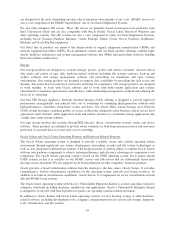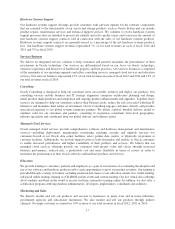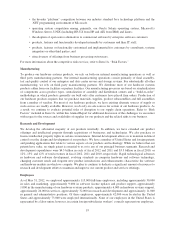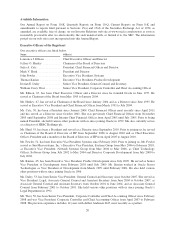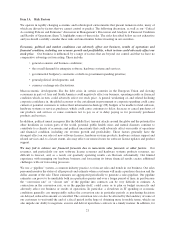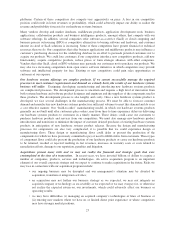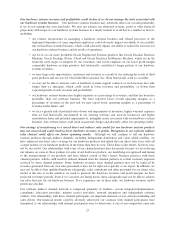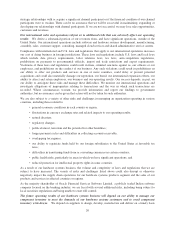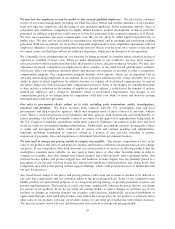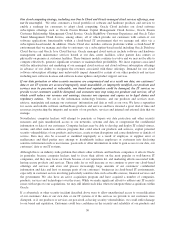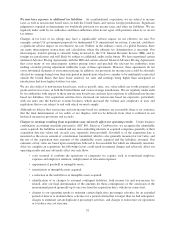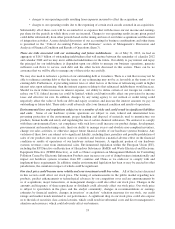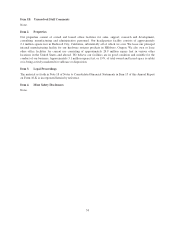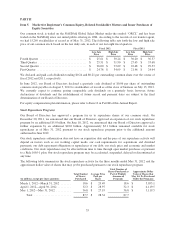Oracle 2012 Annual Report Download - page 29
Download and view the complete annual report
Please find page 29 of the 2012 Oracle annual report below. You can navigate through the pages in the report by either clicking on the pages listed below, or by using the keyword search tool below to find specific information within the annual report.Our hardware systems revenues and profitability could decline if we do not manage the risks associated with
our hardware systems business. Our hardware systems business may adversely affect our overall profitability
if we do not manage the associated risks. We may not achieve our estimated revenue, profit or other financial
projections with respect to our hardware systems business in a timely manner or at all due to a number of factors,
including:
• our relative inexperience in managing a hardware systems business and related processes or the
unplanned departures of some important employees could adversely impact our ability to successfully
run our hardware systems business, which could adversely impact our ability to realize the forecasts for
our hardware systems business and its results of operations;
• our focus on our more profitable Oracle Engineered Systems products like Oracle Exadata Database
Machine, Oracle Exalogic Elastic Cloud and Oracle Exalytics In-Memory Machine, which are in the
relatively early stages of adoption by our customers, and our de-emphasis on our lower profit margin
commodity hardware systems products that historically constituted a larger portion of our hardware
systems revenues;
• we may forgo sales opportunities, customers and revenues as a result of our reducing the resale of third
party products and services for which Sun Microsystems, Inc. (Sun) historically acted as a reseller;
• we may not be able to increase sales of hardware systems support contracts or such increase may take
longer than we anticipate, which could result in lower revenues and profitability, or slower than
expected growth of such revenues and profitability;
• our hardware systems business has higher expenses as a percentage of revenues, and thus has been less
profitable, than our software business. We have reported lower overall operating margins as a
percentage of revenues in the past and we may report lower operating margins as a percentage of
revenues in the future; and
• we face a greater risk of potential write-downs and impairments of inventory, higher warranty expenses
than we had historically encountered in our existing software and services businesses and higher
amortization from, and potential impairment of, intangible assets associated with our hardware systems
business. Any of these items could result in material charges and adversely affect our operating results.
Our strategy of transitioning to a mixed direct and indirect sales model for our hardware systems products
may not succeed and could result in lower hardware revenues or profits. Disruptions to our software indirect
sales channel could affect our future operating results. Although we will continue to sell our hardware
systems products through indirect channels, including independent distributors and value added resellers, we
have enhanced our direct sales coverage for our hardware products and intend that our direct sales force will sell
a larger portion of our hardware products in the future than they do now. These direct sales efforts, however, may
not be successful. Our relationships with some of our channel partners may deteriorate because we are reducing
our reliance on some of these partners for sales of our hardware products, are modifying our approach and timing
to the manufacturing of our products and have altered certain of Sun’s legacy business practices with these
channel partners, which could result in reduced demand from the channel partners or certain customer segments
serviced by these channel partners. Some hardware revenues from channel partners may not be replaced by
revenues generated from our own sales personnel or may not be replaced as quickly as we expect. In addition, we
may not be able to hire qualified hardware salespeople, sales consultants and other personnel for our direct sales
model at the rate or in the numbers we need to generate the hardware revenues and profit margins we have
projected for future periods. Even if we can meet our hiring needs, these salespeople may not be able to achieve
our sales forecasts for our hardware business. If we experience any of these risks, our hardware revenues and/or
profits may decline.
Our software indirect channel network is comprised primarily of resellers, system integrators/implementers,
consultants, education providers, internet service providers, network integrators and independent software
vendors. Our relationships with these channel participants are important elements of our software marketing and
sales efforts. Our financial results could be adversely affected if our contracts with channel participants were
terminated, if our relationships with channel participants were to deteriorate, if any of our competitors enter into
25



